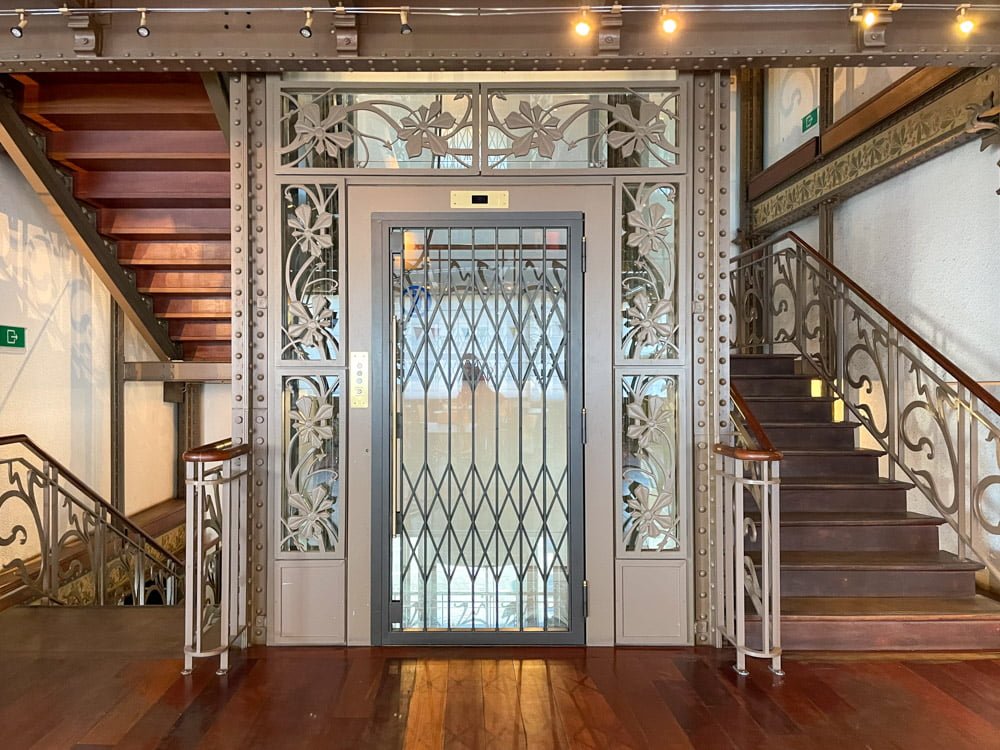The Musée des Instruments de Musique, the Museum of Musical Instruments, located in Brussels, is home to one of the largest collections of musical instruments. Housed in a beautiful Art Nouveau building, the museum features ancient and modern instruments worldwide, offering an immersive experience to explore the sounds of the different instruments. It also explains how music has evolved with the help of the interactive audio guide.
Table of Contents
The Old England building
The Musée des Instruments de Musique is in the heart of Brussels, in the iconic Old England building. The museum offers a glimpse of fantastic architecture inside and outside. It is a must-visit for those interested in Art Nouveau.
PLAN YOUR TRIP TO BRUSSELS
Make the most of your trip to Brussels by purchasing the Brussels City Card online. With access to the city’s top museums and free public transport, it’s the smartest way to explore the city and save money.
To stay connected in Brussels, purchase an Airalo eSim online for phone and data coverage during your trip to Belgium.
Designed by architect Paul Saintenoy in 1899, the Old England building is a fine example of Art Nouveau style, built to house a department store of the same name. It has intricate cast iron and wrought iron details inspired by the plant world. The museum’s location is truly striking and provides a unique experience for visitors.
The Old England building houses a concert hall, library with musical editions, restoration workshop, museum shop, and restaurant with a beautiful terrace overlooking Brussels, in addition to the Museum of Musical Instruments.

What to see at MIM, the Musical Instrument Museum in Brussels
The Museum of Musical Instruments in Brussels is globally renowned for its remarkable collection of musical instruments from various countries. That makes it one of the most significant music museums in the world. The museum boasts a collection of over 10,000 musical instruments. 1200 are displayed across four floors for visitors to explore. The collection is well-organized in the rooms, chronologically and by instrument type.
Upon arrival, visitors receive a tablet with headphones to explore Musée des Instruments de Musique. The tablet provides an interactive experience following the thematic paths of the museum. It offers in-depth information, allows visitors to hear the sounds of the instruments presented and listen to excerpts from concerts.

The musical instruments collection
The museum boasts an extensive collection of musical instruments, including trumpets, violins, bagpipes, harpsichords, bells, drums, pianos, saxophones, and more. During your visit, you’ll have the opportunity to explore a variety of ancient and modern musical instruments from the Western world. Including lesser-known instruments such as the viola da gamba played at the Brussels Court and the theremin.
In addition to the ‘classical’ instruments, the museum also displays non-European instruments with unique sonorities and construction techniques. The Traditions in the World exhibit showcases diverse musical instruments from Asia, Africa, and the Americas, which are used for entertainment or linked to special ceremonies. You can also listen to audio guides on the museum’s tablet to learn more about these instruments.

History of European Musical Instruments
The section dedicated to the history of musical instruments in Europe tells the story of the evolution of instruments according to the genre of music played and the needs of the performers. It begins with wind instruments used in ceremonies, festivals, and processions since the Middle Ages. The section also describes the emergence of professional musicians who settled in urban centres and formed guilds like other trades during the same period.
After horns and trumpets, the museum tour takes you on a journey to explore the new instruments that existed during the Renaissance. The instruments include lutes, harpsichords, and other stringed instruments primarily played in the family.

Music from homes to concert halls
The tour explains how the emergence of theatres and concert halls led to the creation of many new musical instruments. Opera, a genre born in Italy that combined music and theatre played a significant role in developing later musical instruments. Claudio Monteverdi’s Orfeo of 1607 was the first production in which a composer chose which instruments to use in the various scenes.
String instruments are the most representative of historical periods. At the Musée des Instruments de Musique, you can see how they transformed in appearance and sound according to the fashions of the time, constantly renewing themselves. The only instrument abandoned was the harpsichord, overshadowed by the advent of the piano, which offered greater freedom to musicians.
Brass instruments and marching bands
When brass instruments replaced wooden ones for playing outdoors during civil and military marches, musical compositions had a new impetus. The saxophone, invented by Adolphe Sax, a Belgian music designer from Dinant, played a significant role in the 20th century’s love for band music, along with trumpets and trombones. In Belgium, in particular, the popularity of marching bands is incredible, with over 4,000 of them in existence by 1900.

Keyboards
The Museum of Musical Instruments in Brussels does not arrange the room dedicated to keyboards chronologically or by type. However, it still manages to showcase the Western world’s passion for this instrument by placing clavichords and harpsichords alongside modern keyboards.
In this section of the exhibition, you can also observe curious experiments with automatic keyboards, which are cumbersome mechanisms that mechanically press the keys of a piano placed in front of them. Organs, harpsichords, and pianos of all types and eras are also on display, providing a complete overview of this musical instrument.
Traditions around the world
A whole floor of the MIM Musée des Instruments de Musique exhibition is about musical traditions. The exhibit starts with the popular instruments of Belgium. Then, it takes you on a journey through the musical traditions of Europe and the world. The most fascinating aspect of this plan is discovering the similarities and differences of the musical instruments used worldwide.
For instance, bagpipes are not unique to Scotland, as every European region has its version. The most impressive musical instruments are those used in Asia. In contrast, African drums served to spread information rapidly, similar to how we use social networks today instead of musical instruments. You will be amazed to discover the creative ways different cultures use music to communicate and connect.

Musicus Mechanicus
The Musicus Mechanicus exhibition in the basement of the Museum of Musical Instruments in Brussels is a must-see. This exhibition displays the mechanical, electrical, and electronic collections. I found it fascinating to see the first gramophones and record players intended for home use, which were bulky and cumbersome compared to today’s musical reproduction instruments.
Practical information for visiting the Museum of Musical Instruments in Brussels
The MIM Musée des Instruments de Musique is open every day except Monday, with the last admission at 4:30 pm. Although the average duration of the visit is about two hours, you can easily spend much more time in the museum as it is exciting. The tablet with the audio guide included in the entrance ticket price is an integral part of the visit. You can bring your own headphones or use the ones provided by the museum, disinfected after each use.
During my last visits (I return to this museum every time I come to Brussels), the panoramic restaurant on the museum’s top floor was closed for renovation. Therefore, check if it has reopened on the museum’s website when planning your visit. If it has, planning your day to have lunch or brunch in one of the most iconic buildings in Brussels’ historic centre is definitely worth planning.

How much tickets to the Museum of Musical Instruments in Brussels cost
The admission fee for the Musical Instrument Museum is €15. If you plan to visit several museums during your trip, I suggest getting the Brussels City Card, which includes entry to this museum. However, if you only intend to see this particular museum or a couple of other ones, it may be more cost-effective to purchase individual tickets instead.
How to get to the Musical Instrument Museum in Brussels
The Musical Instrument Museum in Brussels is located in the centre of the Belgian capital. It is near the Musée Magritte, the BELvue Museum and the Place Royale. Depending on the position of your hotel, it may be quicker to reach the museum on foot than by public transport due to its central location. On foot, you can also admire the beautiful architecture of the centre of Brussels.
MIM Musée des Instruments de Musique
Rue Montagne de la Cour 2
1000 Bruxelles
Where to stay in Brussels
I have visited Brussels many times, and I can confidently say that the city offers a wide range of accommodation options to suit different travel styles. If you are looking for a hotel in the city centre, the Pillows City Hotel Brussels Centre is an excellent choice. It is located just 100 metres from Brussels Central Station and within a five-minute walk of the Grand Place and the Manneken Pis statue, making it ideal for exploring the city on foot.
Right in the heart of Brussels, Made in Catherine is located on Place Sainte-Catherine, only a ten-minute walk from the Grand Place. This small hotel is particularly appreciated for its fantastic buffet breakfast and its lively yet authentic neighbourhood.
In the European Quarter, for an especially romantic stay, Faubourg 21 is a refined five-star hotel offering a spa, wellness centre and a terrace. It is a great option if you want to combine sightseeing with relaxation in an elegant setting.
If you prefer staying in an apartment, Teddy Picker offers well-designed studios with a garden or terrace. The property also features a family-friendly restaurant serving Belgian and international cuisine for lunch and dinner, including vegetarian and vegan options.
Feel free to leave a comment below if you have had the opportunity to visit the Musical Instrument Museum in Brussels or if you are planning to do so in the future. Thank you for sharing!
